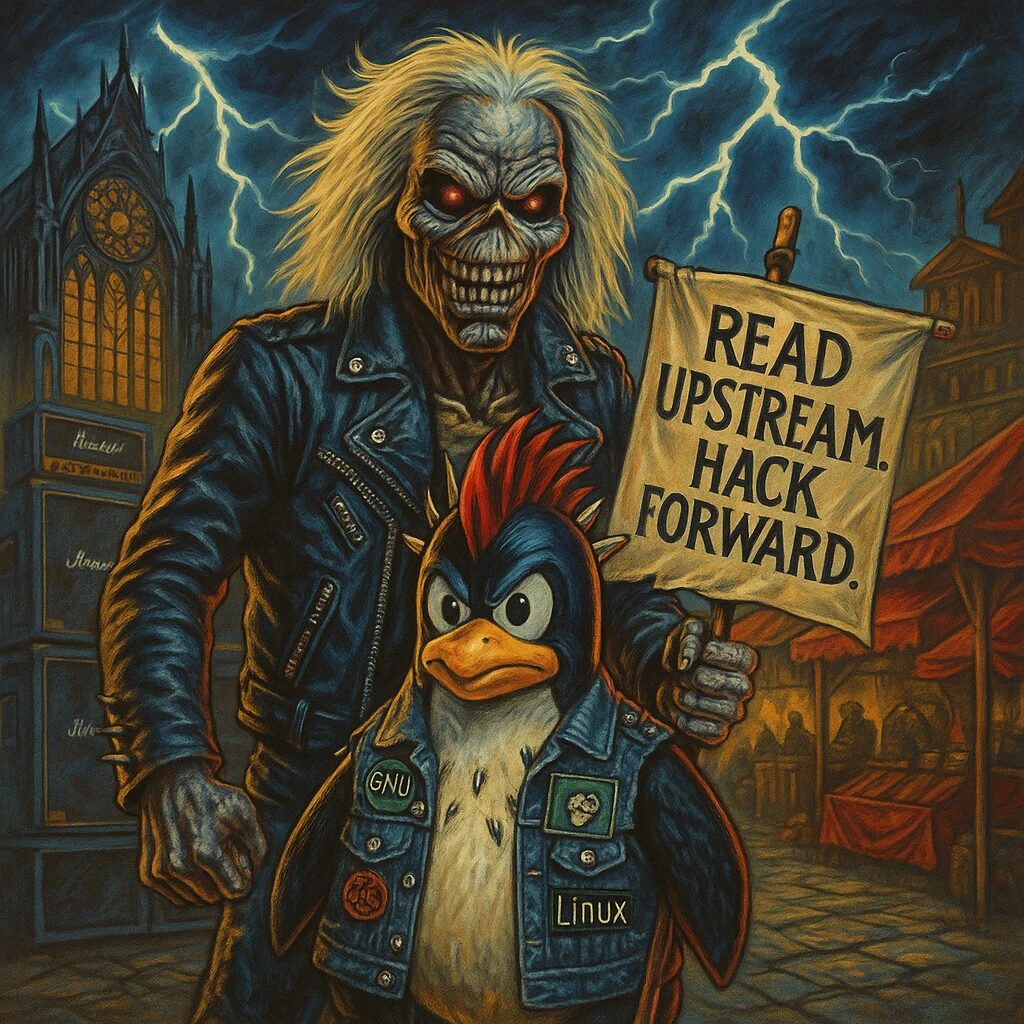How a kid of the ’70s learned to read, hack, and share—because the riffs were irresistible
Abstract
This thesis argues that Iron Maiden are an “open-source band” operating at the seam between Cathedral (the canon of history and literature) and Bazaar (the open, iterative culture of fans, covers, tabs, and tours). Growing up in the ’80s, I absorbed Coleridge, Tennyson, Huxley, and whole chapters of military history through Maiden—not because they set out to educate, but because their art entertains so powerfully that learning becomes an unintended but inevitable side effect. Their visible attribution of sources, long-horizon maintainership, and community propagation mirror GNU/Linux culture: read upstream, remix with respect, ship improvements, credit loudly, share back.
1) Overture: the riff that opened a library
I didn’t meet the canon in a classroom; I met it on vinyl. Maiden’s sleeves felt like grimoires; their songs were siege engines aimed at the gates of history and lit. Day one of Senior English, when Rime of the Ancient Mariner came up, I could already map the albatross to guilt and penance and recite key lines from memory—because Maiden had drilled the poem into me while entertaining me. That was my first proof that metal can educate without trying to.
2) The thesis: Open source by method; pedagogy by accident
- Open source by method. Maiden expose their influences, transform them with craft, and publish the results back into a culture that studies and extends them.
- Pedagogy by accident. The band isn’t a classroom. They aim to thrill—and in chasing the thrill, you chase their references. Curiosity fires before instruction arrives. The result is a self-selected, highly motivated learner—exactly the kind of contributor open source depends on.
3) Cathedral vs. Bazaar (cranked to 11)
- The Cathedral: Coleridge, Tennyson, Huxley; Passchendaele’s mud, D-Day’s surf, the R101’s night sky. Curated, enduring, exacting.
- The Bazaar: gigs, bootlegs, fanzines, tabs, YouTube lessons, tribute albums, late-night tempo arguments. Crowded, iterative, many-eyed.
Maiden stand astride both. They mine the Cathedral for upstream “code” and release playable builds into the Bazaar, where thousands learn, fork, and iterate—often without realizing they’re being educated.
4) Source riffs: pull requests from history and literature
- “Rime of the Ancient Mariner” → Coleridge. A faithful port from poem to metal epic; structure preserved, medium transmuted.
- “The Trooper” → Tennyson & the Crimean War. Same narrative payload, first-person interface—maximum immediacy.
- “Brave New World” → Huxley. Title, imagery, and tone as import statements; the dystopia lands in the present tense.
- “Paschendale,” “The Longest Day,” “Montségur” → history. War as systems thinking: terrain, logistics, ideology, human cost.
- “Empire of the Clouds” → R101. An 18-minute post-mortem set to piano and orchestra: incident analysis rendered as art.
- “To Tame a Land” → Dune. When boundaries appear, rename and ship—license-savvy craft that keeps inspiration intact.
Key point: None of these tracks arrives wagging a finger. They entertain first—and that very entertainment lures you upstream to the text, the battle, the archive.
5) The maintainer model (why the catalogue feels like a codebase)
- Steve Harris = lead maintainer. Taste, gates, guardrails. The gallop is a style guide; twin leads are conventions; Eddie is the mascot.
- Producers and co-writers = subsystem owners. Integration responsibility for tone, dynamics, and performance budgets.
- Albums = major releases; tours = nightly builds. Setlists are real-time A/B tests; arrangements get crowd-tested, refined, and re-released.
This is the survival logic of GNU/Linux applied to music: attribution → review → iteration → release.
6) Incidental pedagogy: how entertainment becomes education
Why does Maiden educate without trying?
- Transparent sources. Titles, lyrics, and art point you to the upstream. No syllabus required.
- Narrative hooks. Big stakes, vivid imagery, moral arcs—your brain wants the backstory.
- Replay addiction. Repetition makes rhythms and references sticky; curiosity grows in the pauses.
- Community rehearsal. Tabs, covers, and breakdowns require close reading—the same discipline as reading code or primary sources.
- Respectful remix. By honoring boundaries (credit, fidelity, renaming when needed), the band models how to build on prior work ethically.
7) Personal payload: the hacker’s habits I learned from metal
- Chase upstream. Liner-note breadcrumbs trained me to hunt the poem, the battle, the design doc.
- Refuse fragments. Don’t settle for a chorus or a snippet—read the whole thing. Context prevents shallow takes.
- Respect constraints. Quote where allowed, summarize where required, rename when blocked. Ship clean.
- Honor maintainers. Strong review culture outlives trends—whether in a kernel or a catalogue.
8) Mini-postmortems (because we learn from the wreckage)
- “Rime…”: Semantic port; risk of melodrama managed by pacing and dynamics—result: endurance classic.
- “Trooper”: API shift to first-person; adoption explodes; riff becomes lingua franca for players.
- “Empire of the Clouds”: Scope accepted; runtime justified by historical fidelity; outcome: longest track, maximum signal.
- “To Tame a Land”: Boundary encountered; rename and release; inspiration preserved, compliance upheld.
Each choice teaches—not as a lesson plan, but as the inevitable residue of excellent entertainment done with rigor and respect.
9) Conclusion: the nave, the marketplace, and the terminal prompt
Iron Maiden build in the Cathedral—patient craft, canonical sources—and thrive in the Bazaar—transparent influences, communal iteration. Their superpower is simple and rare: they entertain so hard that you end up educated—curious, sourced-up, and ready to contribute.
That’s why, to me, Maiden are the most open-source band on earth. They turned a boombox into a library, a pit into a seminar, and, eventually, a command prompt into a workshop. The rule they etched in me still holds:
Read upstream. Hack forward. Credit loud. Share back.
And if the soundtrack to that law is twin guitars and a gallop—so much the better.

